Health Care > EXAM > ATI MENTAL HEALTH PRACTICE EXAM 2023-2024 QUESTIONS WITH ANSWERS 100% SCORES A GRADE (All)
ATI MENTAL HEALTH PRACTICE EXAM 2023-2024 QUESTIONS WITH ANSWERS 100% SCORES A GRADE
Document Content and Description Below
ATI MENTAL HEALTH PRACTICE EXAM 2023-2024 QUESTIONS WITH ANSWERS 100% SCORES A GRADE Clozapine The laboratory report for a client taking clozapine shows a white blood cell count of 3000 mm3 What i... s the nurse’s best action? a. Report the results to the health care provider immediately. b. Administer the next dose as prescribed. c. Give aspirin and force fluids. d. Repeat the laboratory test. ANS: A These laboratory values indicate the possibility of agranulocytosis, a serious side effect of clozapine therapy. These results must be immediately reported to the health care provider, and the drug should be withheld. The health care provider may repeat the test, but in the meantime, the drug should be withheld. (Note: This question requires students to apply previous learning regarding normal and abnormal values of white blood cell counts.) Priority teaching for a patient taking clozapine (Clozaril) should include which instruction? a. Report sore throat and fever immediately. b. Avoid foods high in polyunsaturated fat. c. Use water-based lotions for rashes. d. Avoid unprotected sex. ANS: A Clozapine therapy may produce agranulocytosis; therefore signs of infection should be immediately reported to the health care provider. In addition, the patient should have white blood cell levels measured weekly. The other options are not relevant to clozapine administration Alzheimer’s A patient diagnosed with stage 1 Alzheimer disease tires easily and prefers to stay home rather than attend social activities. The spouse does the grocery shopping because the patient cannot remember what to buy. Which nursing diagnosis applies at this time? a. Risk for injury b. Impaired memory c. Self-care deficit d. Caregiver role strain ANS: B Memory impairment is present and expected in stage 1 Alzheimer disease. Patients diagnosed with early Alzheimer disease often have difficulty remembering names, so socialization is minimized. Data are not present to support the other diagnoses. Which patients meet criteria for hospice services? (Select all that apply.) a. A 92-year-old diagnosed with acute pneumonia and late-stage Alzheimer’s disease b. A 54-year-old diagnosed with glioblastoma and life expectancy of 8 to 10 weeks c. A 16-year-old with type 1 diabetes, multiple infections, and substance abuse d. A 74-year-old newly diagnosed with chronic obstructive pulmonary disease (COPD) and life expectancy of 2 years e. A 36-year-old diagnosed with multiple sclerosis complicated by major depressive disorder and pain associated with muscle spasms ANS: A, B Hospice services are available to patients with terminal illnesses and a life expectancy of less than 6 months. The client must choose hospice care, rather than curative treatments. Although patients with other health problems may experience complications, treatments focusing on cure would exclude them from hospice services. An older adult drove to a nearby store but was unable to remember how to get home or state an address. When police took the person home, the spouse reported frequent wandering into neighbors homes. Alzheimer disease was subsequently diagnosed. Which stage of Alzheimer disease is evident? a. 1 (mild) b. 2 (moderate) c. 3 (moderate to severe) d. 4 (late) ANS: B In stage 2 (moderate), deterioration is evident. Memory loss may include the inability to remember addresses or the date. Activities such as driving may become hazardous, and frustration by the increasing difficulty of performing ordinary tasks may be experienced. Hygiene may begin to deteriorate. Stage 3 (moderate to severe) finds the individual unable to identify familiar objects or people and needing direction for the simplest of tasks. In stage 4 (late), the ability to talk and walk are eventually lost, and stupor evolves A nurse should anticipate that which symptoms of Alzheimer disease will become apparent asthe disease progresses from moderate to severe to late stage? Select all that apply. f. Agraphia g. Hyperorality h. Fine motor tremors i. Hypermetamorphosis j. Improvement of memory ANS: A, B, D The memories of patients with Alzheimer disease continue to deteriorate. These patients demonstrate the inability to read or write (agraphia), the need to put everything into the mouth (hyperorality), and the need to touch everything (hypermetamorphosis). Fine motor tremors are associated with alcohol withdrawal delirium, not dementia. Memory does not improve Delirium When making a distinction as to whether an elderly client is experiencing confusion related to delirium or another problem, what information would be of particular value? a. Evidence of spasticity or flaccidity b. The client’s level of motor activity c. Medications the client has recently taken d. Level of preoccupation with somatic symptoms ANS: C Delirium in the elderly produces symptoms of confusion. Medication interactions or adverse reactions are often a cause. The distracters do not give information important for delirium. Which assessment findings would the nurse expect in a client experiencing delirium? (Select all that apply.) a. Impaired level of consciousness b. Disorientation to place, time c. Wandering attention d. Apathy e. Agnosia ANS: A, B, C Disorientation to place and time is an expected finding. Orientation to person (self) usually remains intact. Attention span is short, and difficulty focusing or shifting attention as directed is often noted. Clients with delirium commonly experience illusions and hallucinations. Fluctuating levels of consciousness are expected. Agnosia occurs with dementia. Apathy is associated with depression. When making a distinction asto whether a patient is experiencing confusion related to depression or dementia, what information would be most important for the nurse to consider? a. The patient with dementia is persistently angry and hostile. b. Early morning agitation and hyperactivity occur in dementia. c. Confusion seems to worsen at night when dementia is present. d. A patient who is depressed is constantly preoccupied with somatic symptoms. ANS: C Both dementia and depression in older adults may produce symptoms of confusion. Noting whether the confusion seems to increase at night, which occurs more often with dementia than with depression, will help distinguish whether depression or dementia is producing the confused behavior. The other options are not necessarily true. Which intervention is appropriate to use for patients diagnosed with either delirium or dementia? a. Speak in a loud, firm voice. b. Touch the patient before speaking. c. Reintroduce the health care worker at each contact. d. When the patient becomes aggressive, use physical restraint instead of medication. ANS: C Short-term memory is often impaired in patients with delirium and dementia. Reorientation to staff is often necessary with each contact to minimize misperceptions, reduce anxiety level, and secure cooperation. Loud voices may be frightening or sound angry. Speaking before touching prevents the patient from feeling threatened. Physical restraint is not appropriate; the least restrictive measure should be used. A hospitalized patient experiencing delirium misinterpret reality, and a patient diagnosed with dementia wanders about the home. Which outcome is the priority in both scenarios? Each patient will: e. remain safe in the environment. f. participate actively in self-care. g. communicate verbally. h. acknowledge reality. ANS: A Risk for injury is the nurse's priority concern in both scenarios. Safety maintenance is the desired outcome. The other outcomes may not be realistic A patient admitted yesterday for injuries sustained while intoxicated believes the window blinds are snakes trying to get into the room. The patient is anxious, agitated, and diaphoretic. Which medication can the nurse anticipate the health care provider will prescribe? a. Monoamine oxidase inhibitor, such as phenelzine (Nardil) b. Phenothiazine, such as thioridazine (Mellaril) c. Benzodiazepine, such as lorazepam (Ativan) d. Narcotic analgesic, such as morphine ANS: C This patient is experiencing alcohol withdrawal delirium. Sedation allows for the safe withdrawal from alcohol. Benzodiazepines are the drugs of choice in most regions because of their high therapeutic safety index and anticonvulsant properties. Antidepressant, antipsychotic, and opioid medications will not relieve the patient's symptoms. Caregiver role strain Which nursing diagnoses are most applicable for a client diagnosed with severe late stage Alzheimer’s disease? (Select all that apply.) f. Acute confusion g. Anticipatory grieving h. Urinary incontinence i. Disturbed sleep pattern j. Risk for caregiver role strain ANS: C, D, E The correct answers are consistent with problems frequently identified for clients with late-stage Alzheimer’s disease. Confusion is chronic, not acute. The client’s cognition is too impaired to grieve. An adult diagnosed with schizophrenia lives with elderly parents. The client was recently hospitalized with acute psychosis. One parent is very anxious, and the other is ill because of the stress. Which nursing diagnosis is most applicable to this scenario? a. Ineffective family coping related to parental role conflict b. Caregiver role strain related to the stress of chronic illness c. Impaired parenting related to client’s repeated hospitalizations d. Interrupted family processes related to relapse of acute psychosis ANS: B Caregiver role strain refers to a caregiver’s felt or exhibited difficulty in performing a family caregiver role. In this case, one parent exhibits stress-related illness and the other exhibits increased anxiety. The other nursing diagnoses are not substantiated by the information given and are incorrectly formatted (one nursing diagnosis should not be the etiology for another). Case management Which client would be most appropriate to refer for assertive community treatment (ACT)? e. One diagnosed with a phobic fear of crowded places. f. One who experienced a single episode of major depressive disorder. g. One who experienced a catastrophic reaction to a tornado in the community. h. One diagnosed with schizophrenia who had four hospitalizations in the past year. ANS: D ACT provides intensive case management for persons with serious persistent mental illness who live in the community. Repeated hospitalization is a frequent reason for this intervention. The distracters identify mental health problems of a more episodic nature. The sibling of a client who was diagnosed with a serious mental illness (SMI) asks why a case manager has been assigned. Which nurse’s reply best cites the major advantage of the use of case management? a. “The case manager can modify traditional psychotherapy for homeless clients so that it is more flexible.” b. “Case managers coordinate services and help with accessing them, making sure the client’s needs are met.” c. “The case manager can focus on social skills training and esteem building in the real world where the client lives.” d. “Having a case manager has been shown to reduce hospitalizations, which prevents disruption and saves money.” ANS: B The case manager helps the client gain entrance into the system of care, can coordinate multiple referrals that so often confuse the seriously mentally ill person and his family, and can help overcome obstacles to access and treatment participation. Case managers do not usually possess the credentials needed to provide psychotherapy or function as therapists. Case management promotes efficient use of services in general, but only ACT programming has been shown to reduce hospitalization (which the sibling might see as a disadvantage). Case managers operate in the community, but this is not the primary advantage of their services. For clients diagnosed with serious mental illness (SMI), what is the major advantage of case management? a. The case manager can modify traditional psychotherapy. b. With one coordinator of services, resources can be more efficiently used. c. The case manager can focus on social skills training and esteem building. d. Case managers bring groups of clients together to discuss common problems. ANS: B The case manager coordinates the care and multiple referrals that so often confuse the seriously mentally ill client and the client’s family. Case management promotes efficient use of services. The other options are lesser advantages or are irrelevant. A client diagnosed with a serious mental illness (SMI) lives independently and attends a psychosocial rehabilitation program. The client presents at the emergency department seeking hospitalization. The client has no acute symptoms but says, “I have no money to pay my rent or refill my prescription.” What is the nurse’s best action? a. Involve the client’s case manager to provide crisis intervention. b. Send the client to a homeless shelter until housing can be arranged. c. Arrange for a short in-client admission and begin discharge planning. d. Explain that one must have active psychiatric symptoms to be admitted. ANS: A Impaired stress tolerance and problem-solving abilities can cause persons with SMI to experience relatively minor stressors as crises. This client has run out of money, and this has overwhelmed her ability to cope, resulting in a crisis for which crisis intervention would be an appropriate response. Inpatient care is not clinically indicated nor is the client homeless (although she may fear she is). Telling the client that she is not symptomatic enough to be admitted may prompt malingering. Medication management A psychoeducational session will discuss medication management for a culturally diverse group of clients. Group participants are predominantly members of minority cultures. Of the four staff nurses below, which nurse should lead this group? a. Very young registered nurse b. Older, mature registered nurse c. Newly licensed registered nurse d. A registered nurse who is very thin ANS: B Persons of minority cultures value age and wisdom. Persons with a Western worldview tend to value youth. An older, mature registered nurse would be the most credible leader of this group. The nurse’s size has no bearing on credibility An elderly client brings a bag of medications to the clinic. The nurse finds bottles of medications as well as assorted pills in no containers in the bag. What is the nurse’s priority action? a. Dispose of all medications that are not in properly labeled bottles. b. Confer with a family member about the client’s management of medication. c. Engage the client in educ [Show More]
Last updated: 7 months ago
Preview 1 out of 35 pages
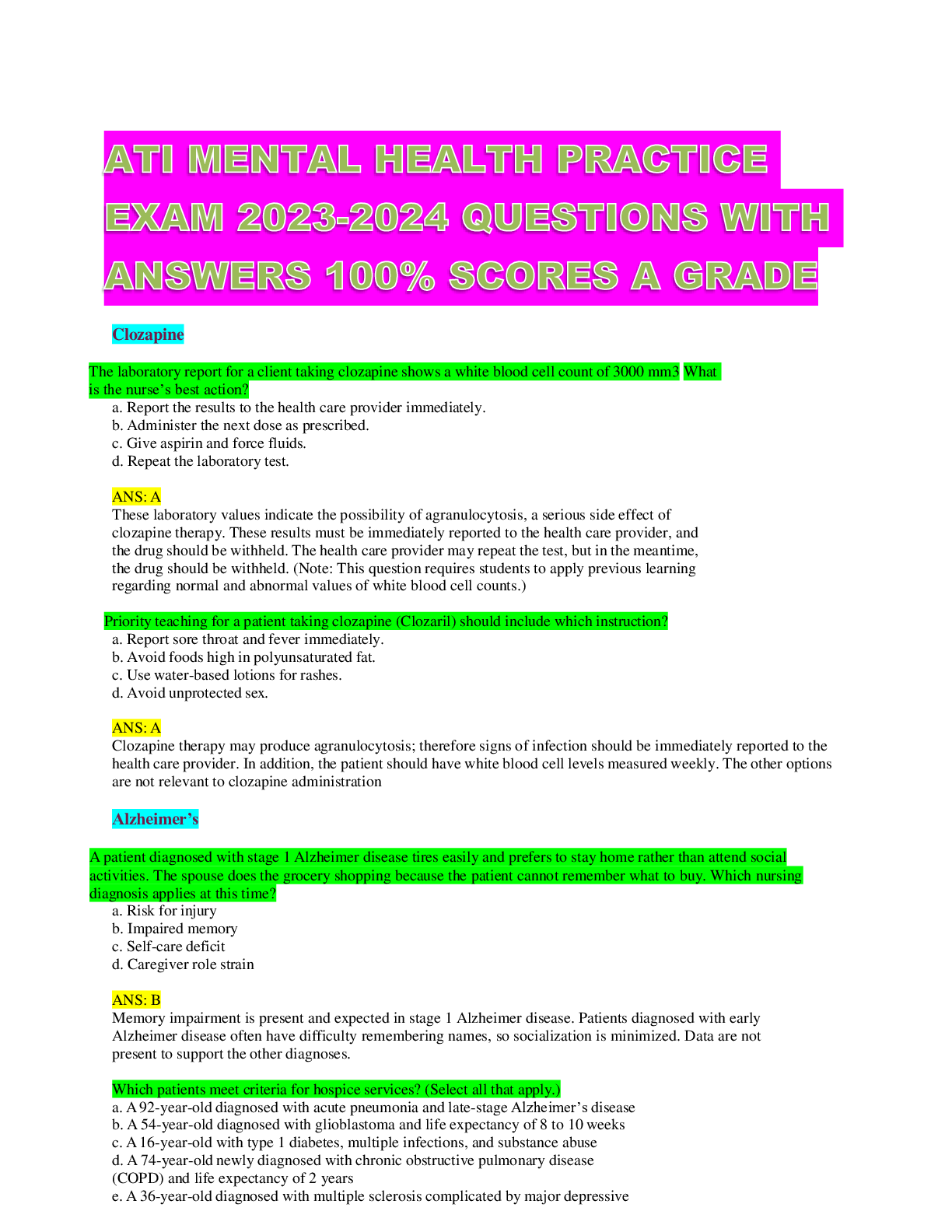
Buy this document to get the full access instantly
Instant Download Access after purchase
Add to cartInstant download
We Accept:

Reviews( 0 )
$14.00
Document information
Connected school, study & course
About the document
Uploaded On
Nov 22, 2023
Number of pages
35
Written in
Additional information
This document has been written for:
Uploaded
Nov 22, 2023
Downloads
0
Views
19

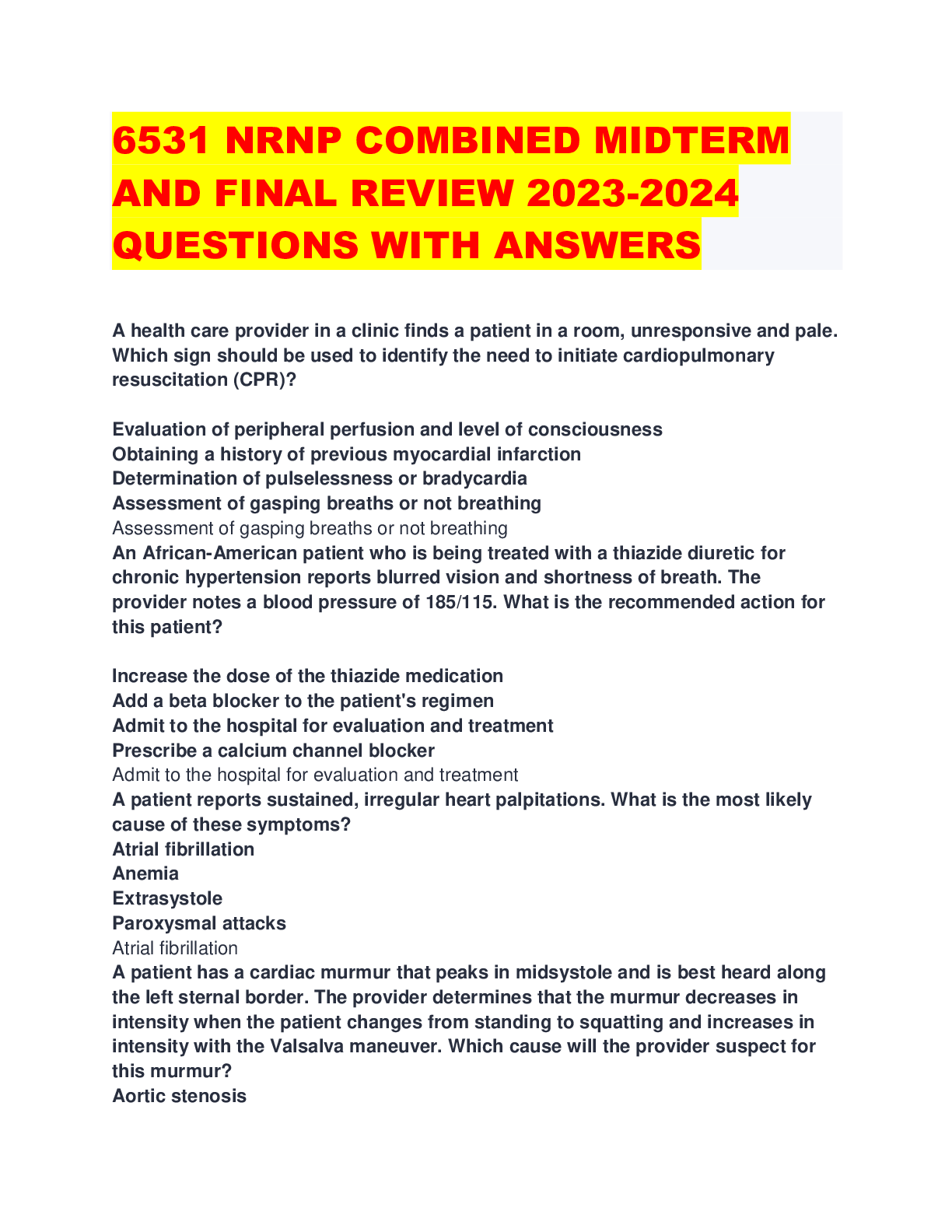
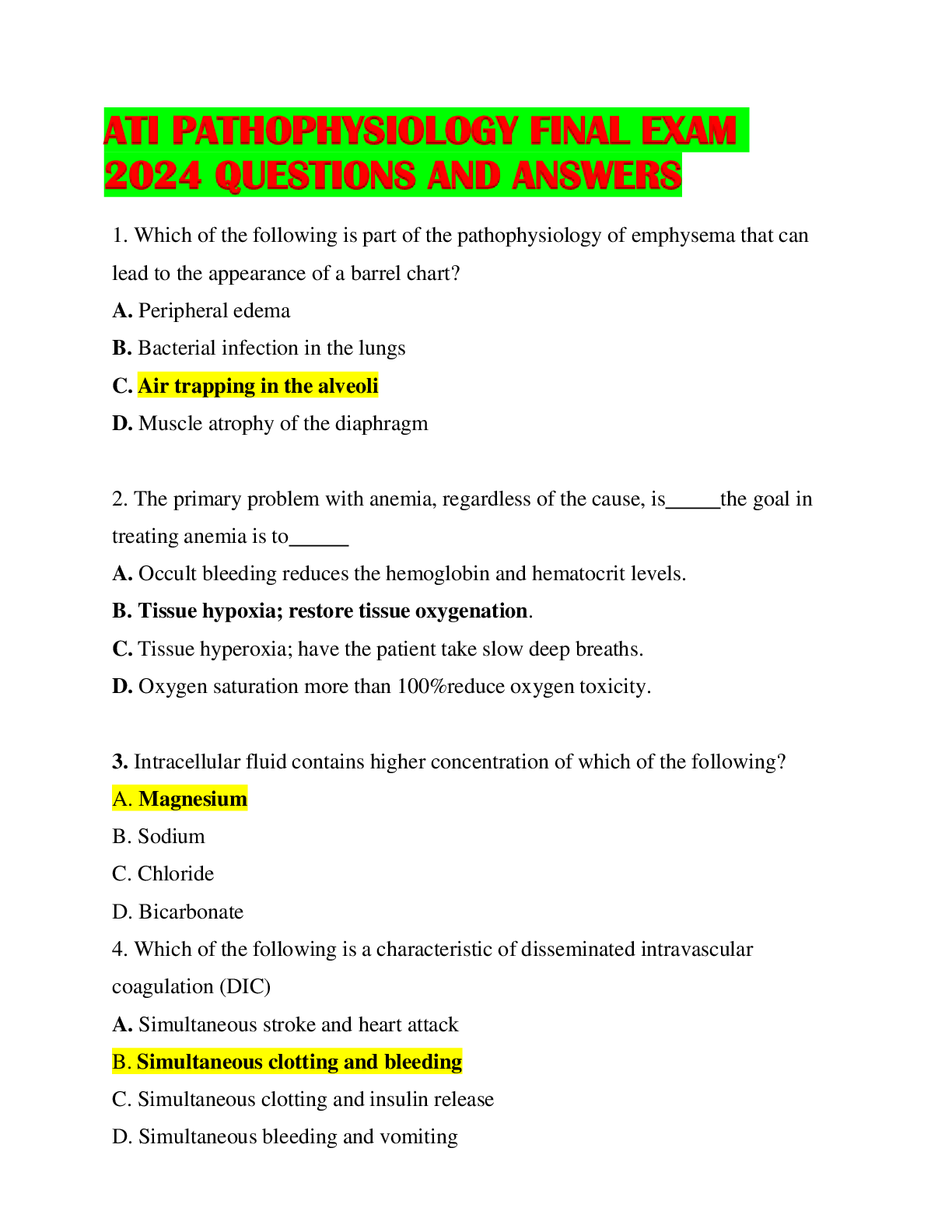

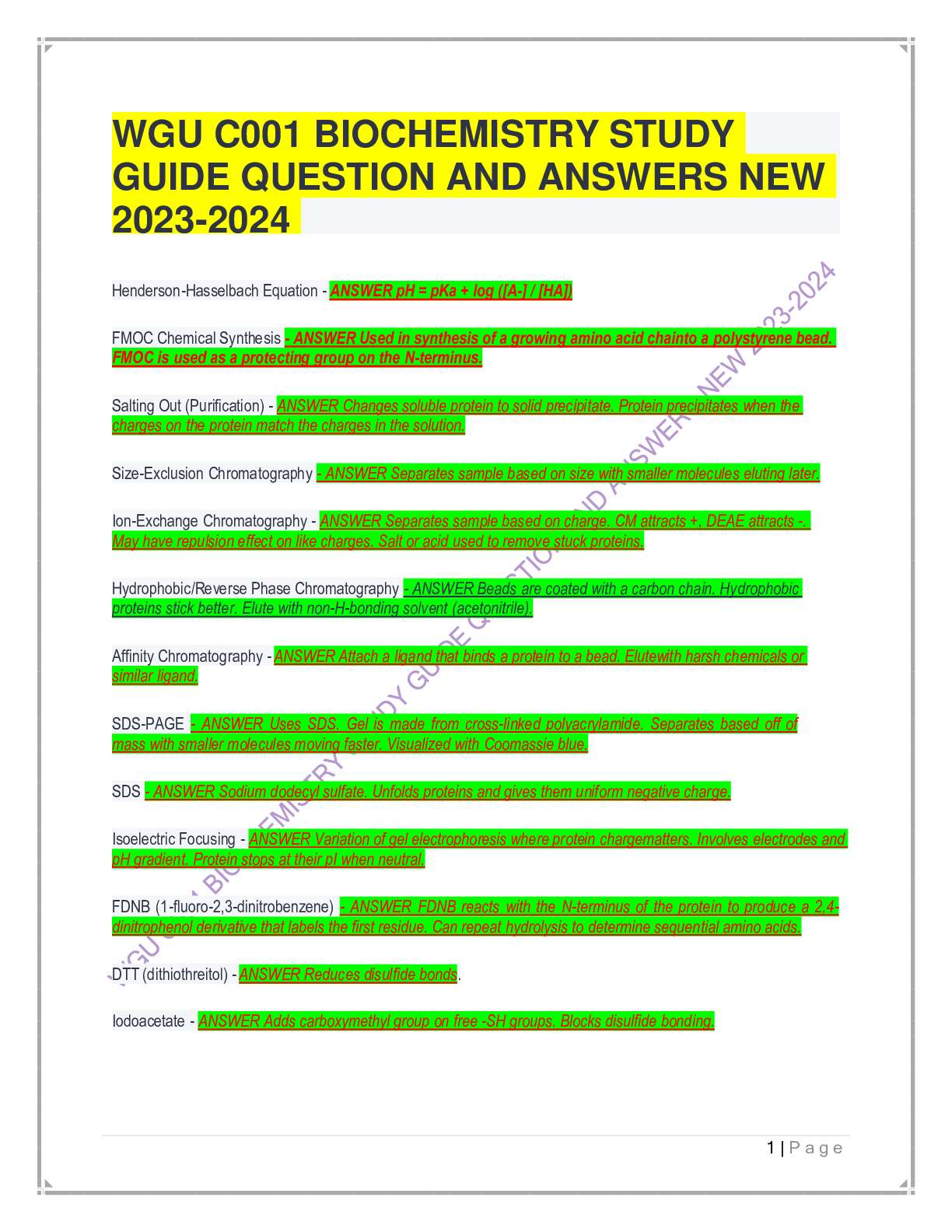
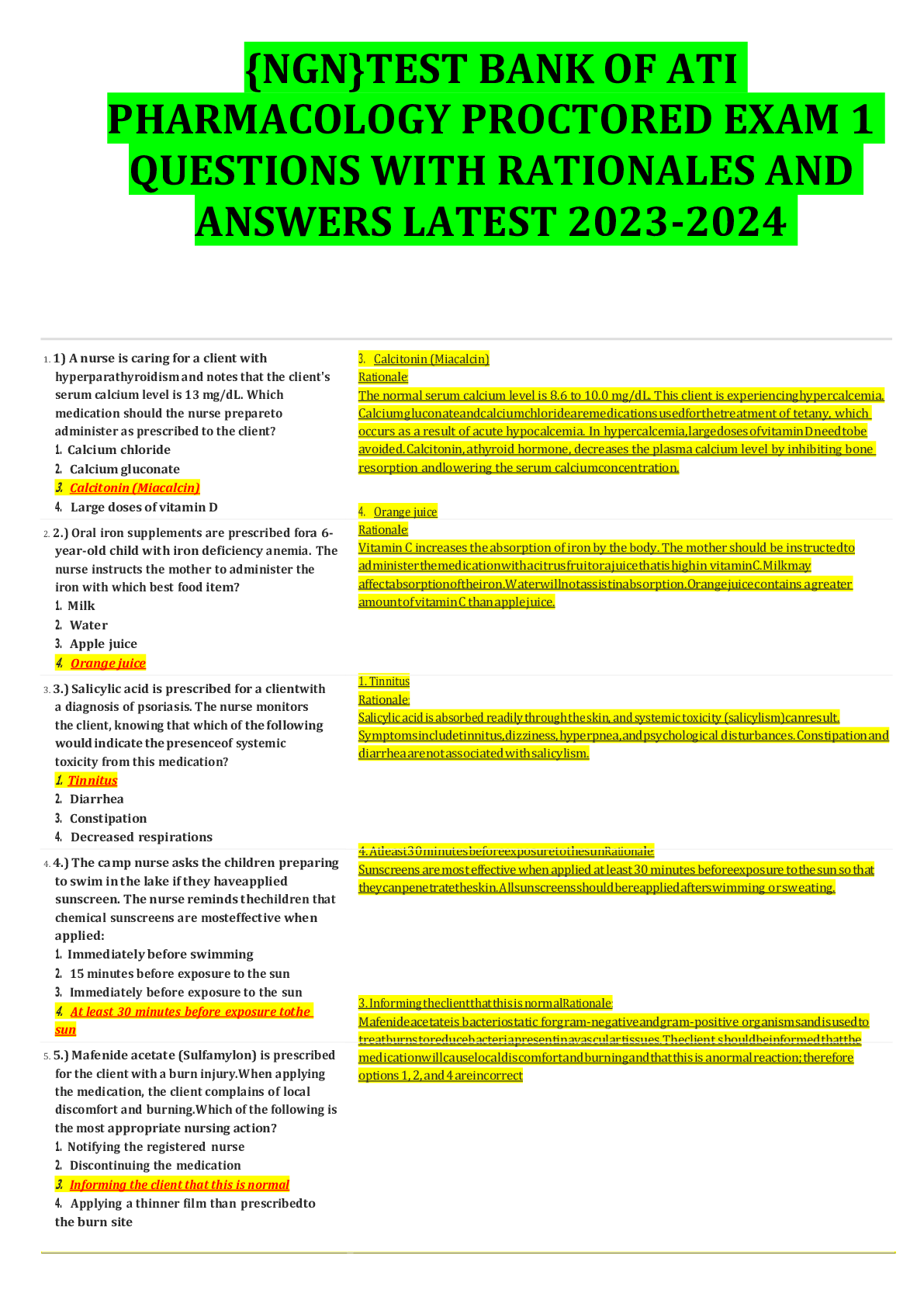

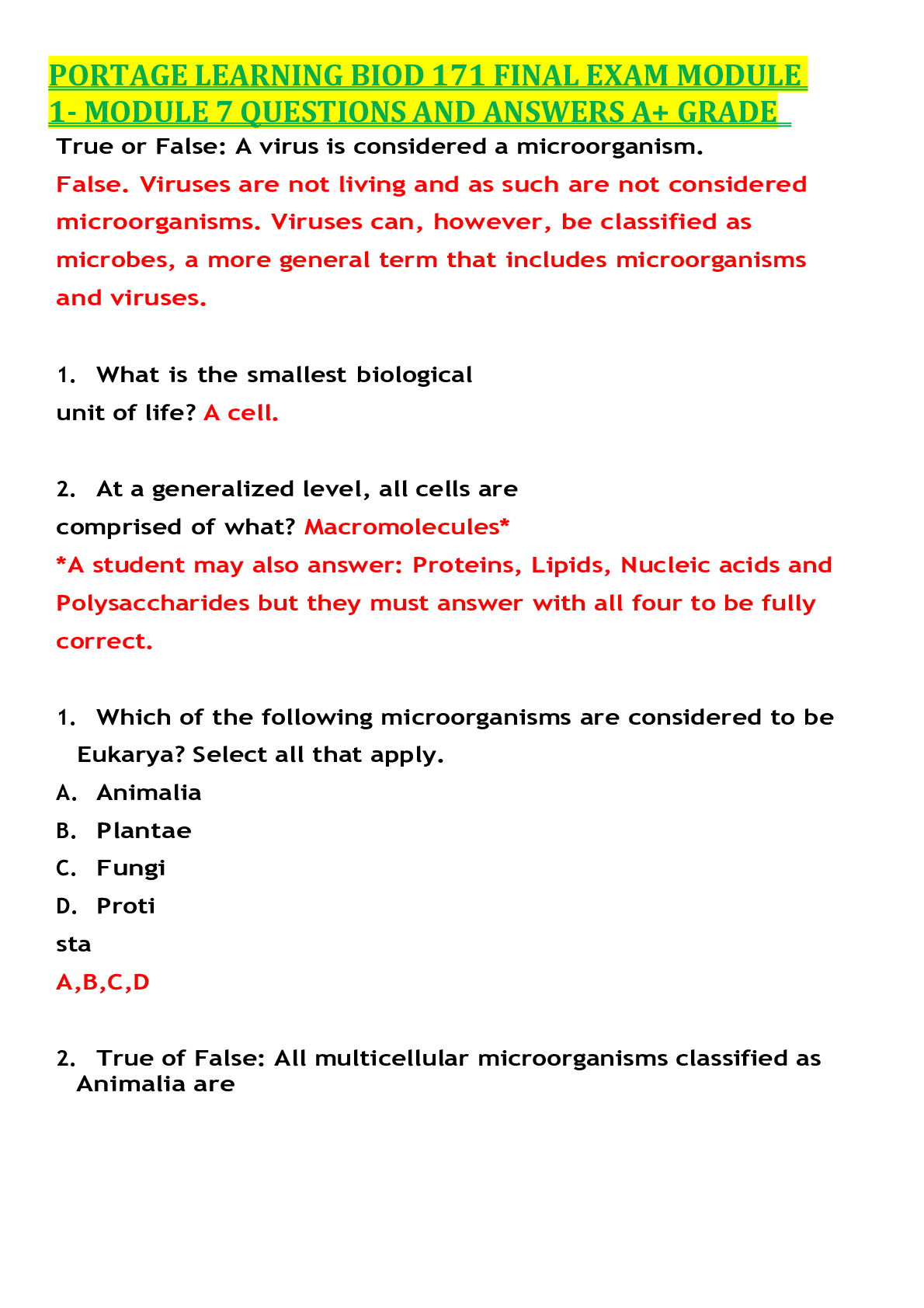

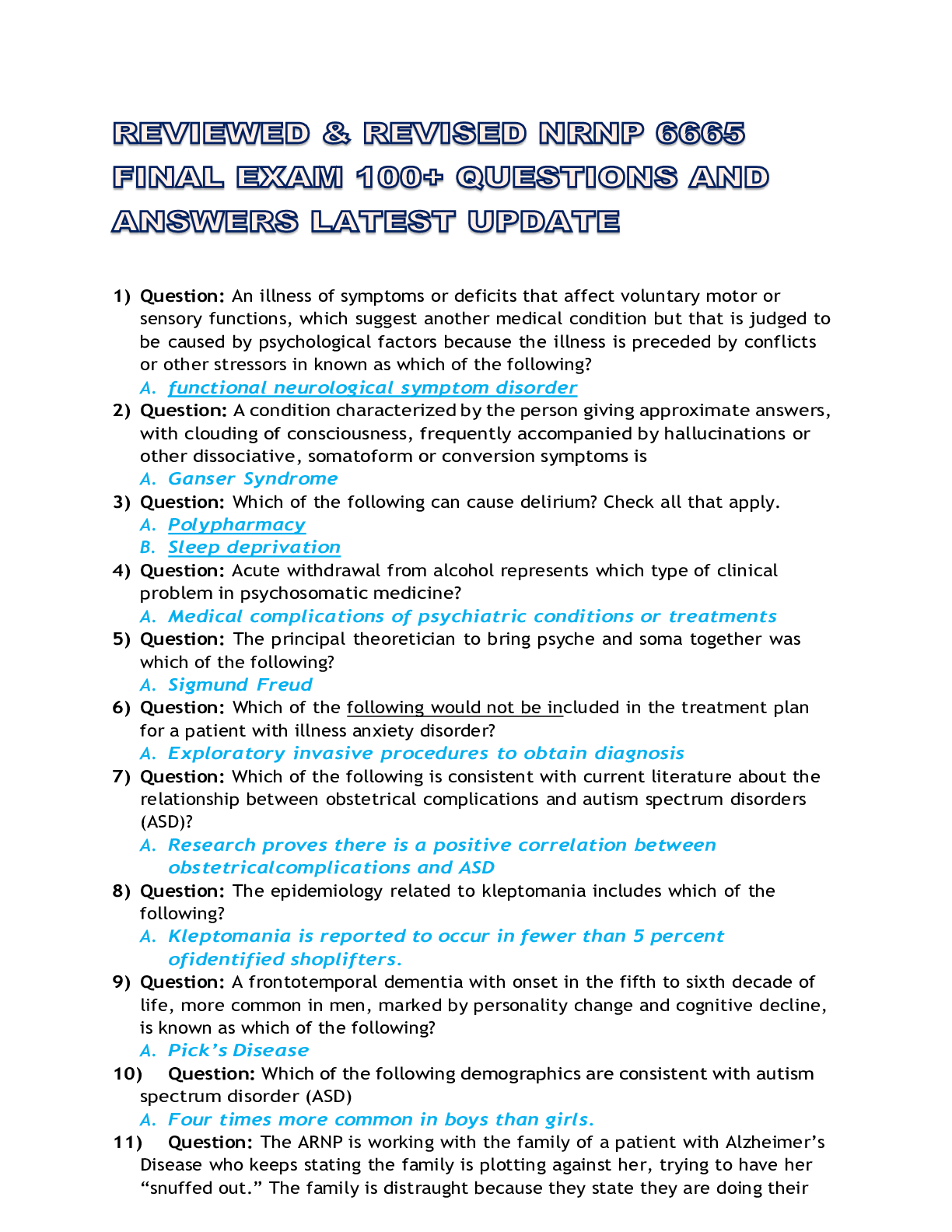

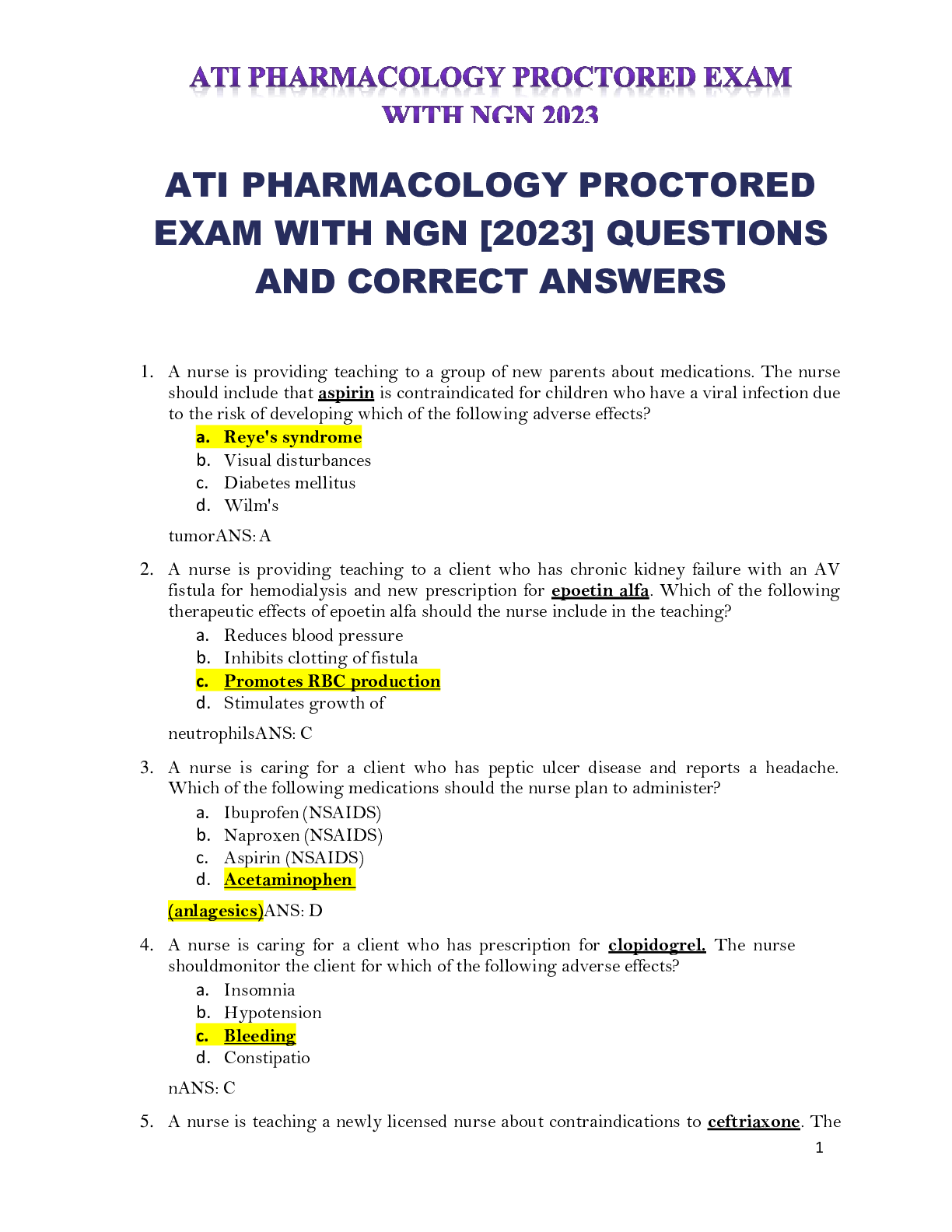

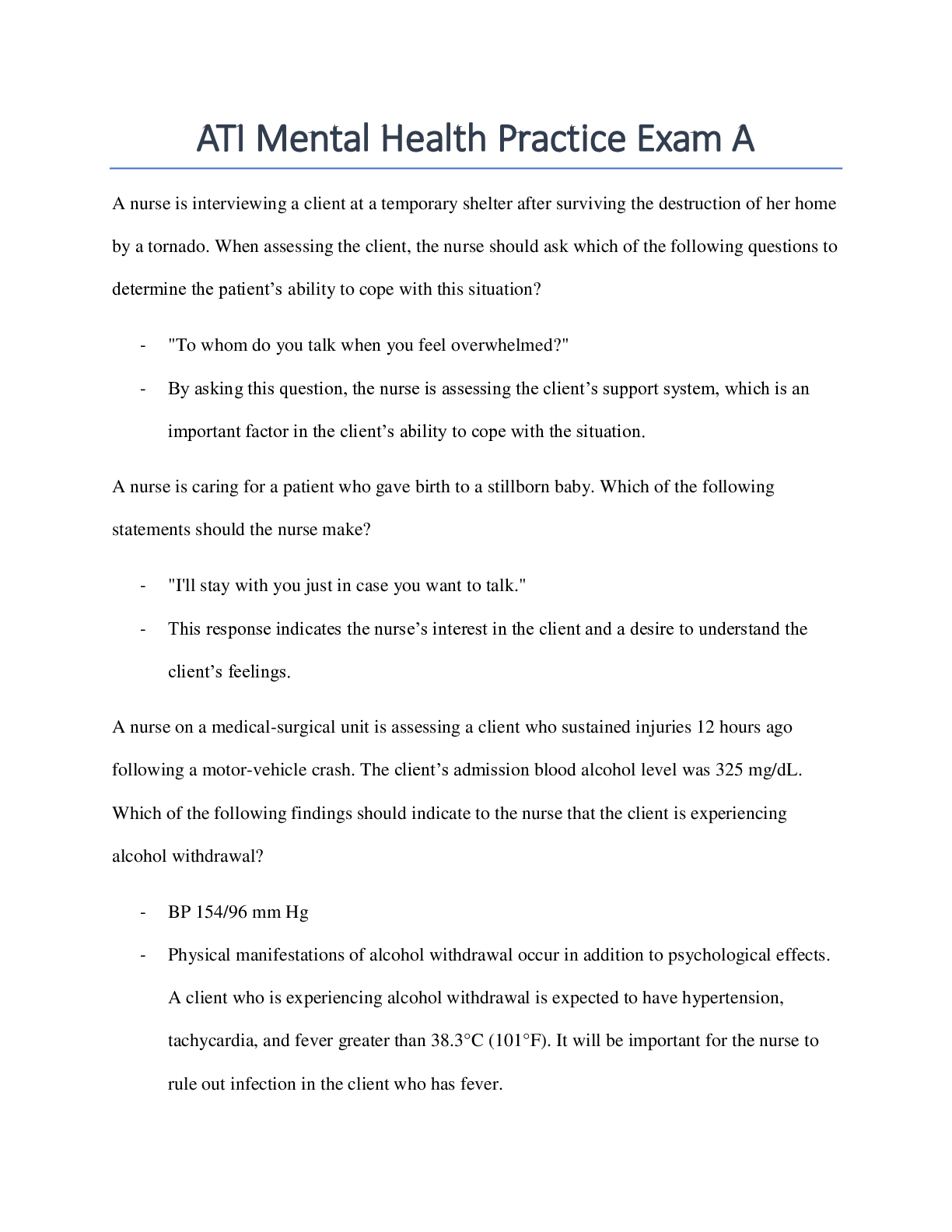
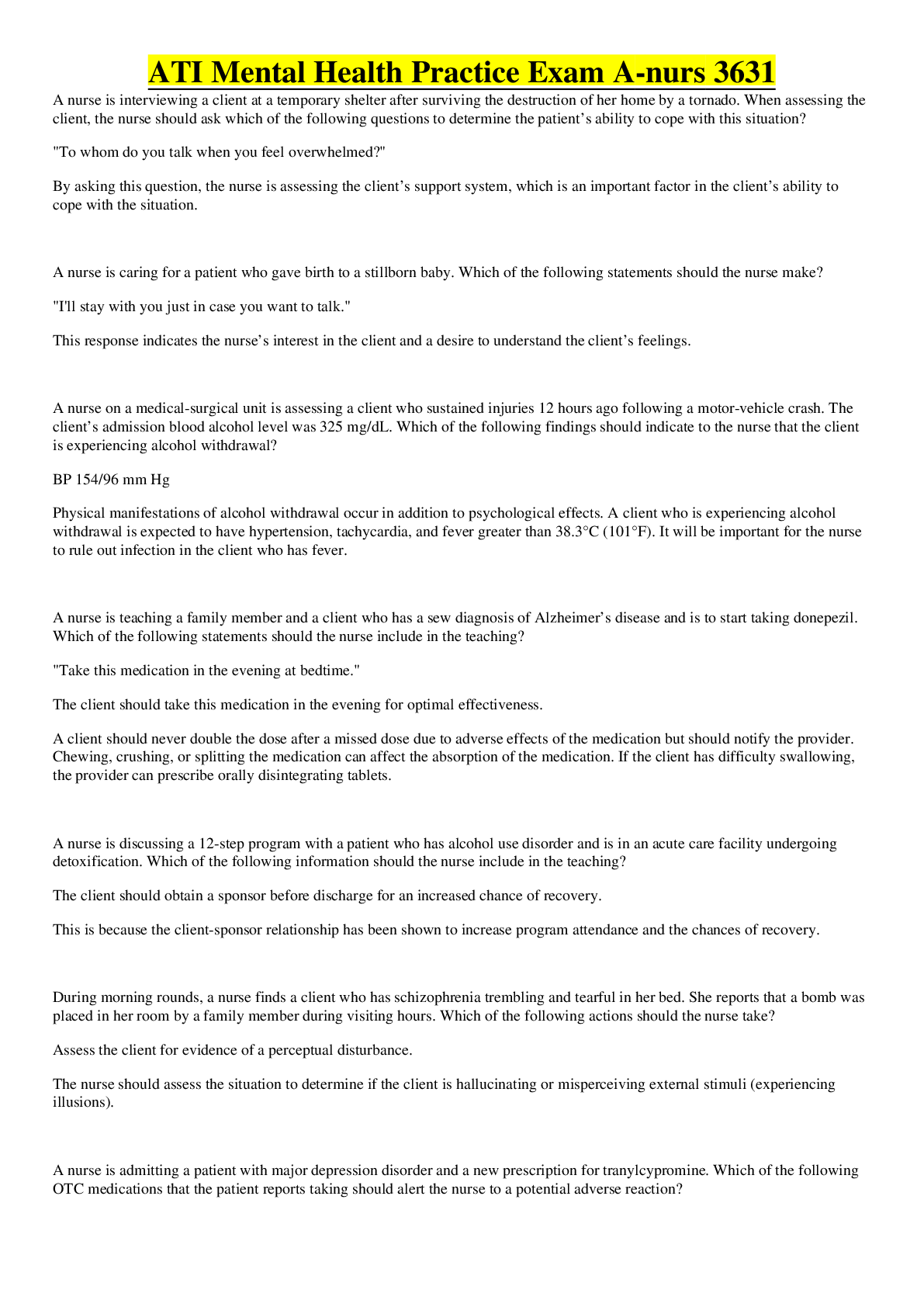
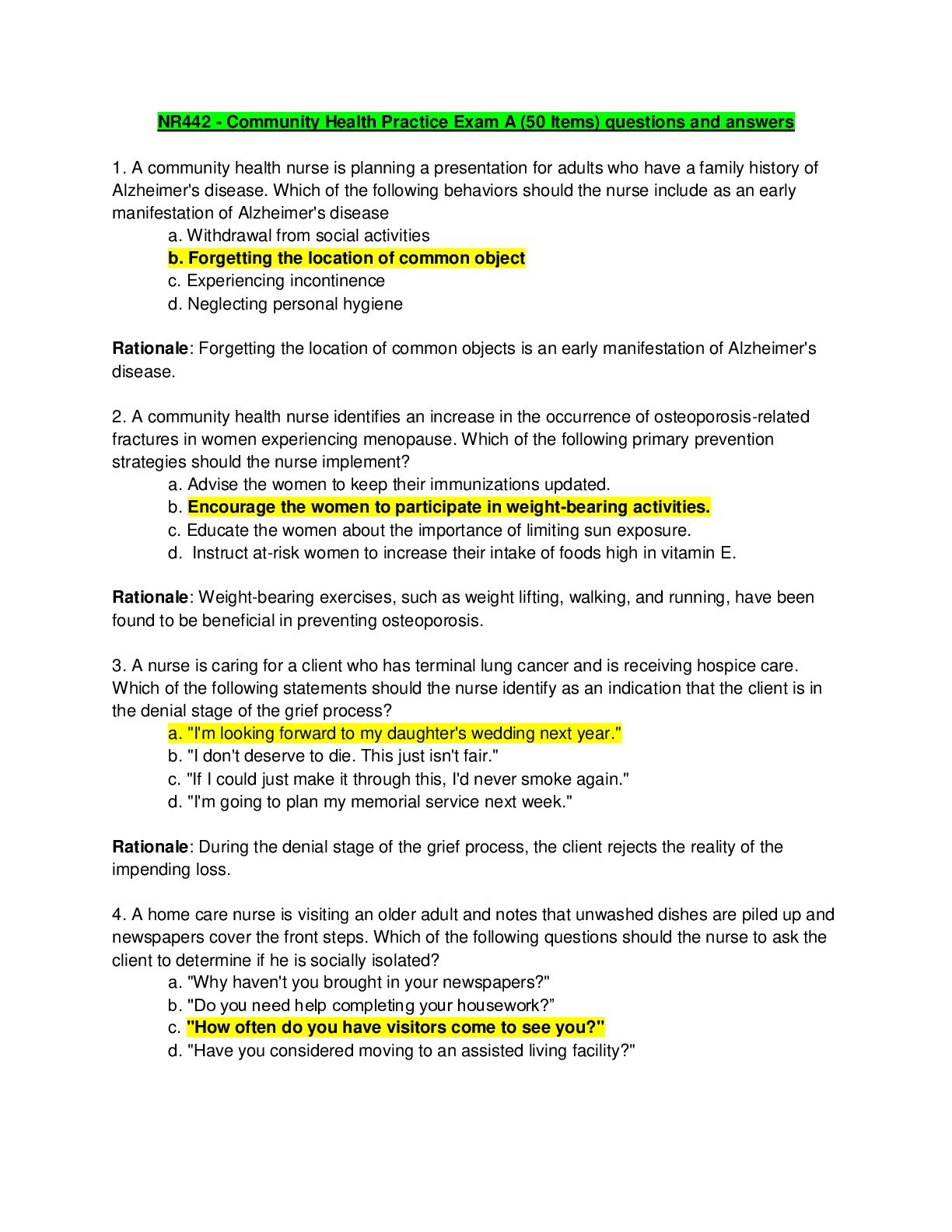
.png)

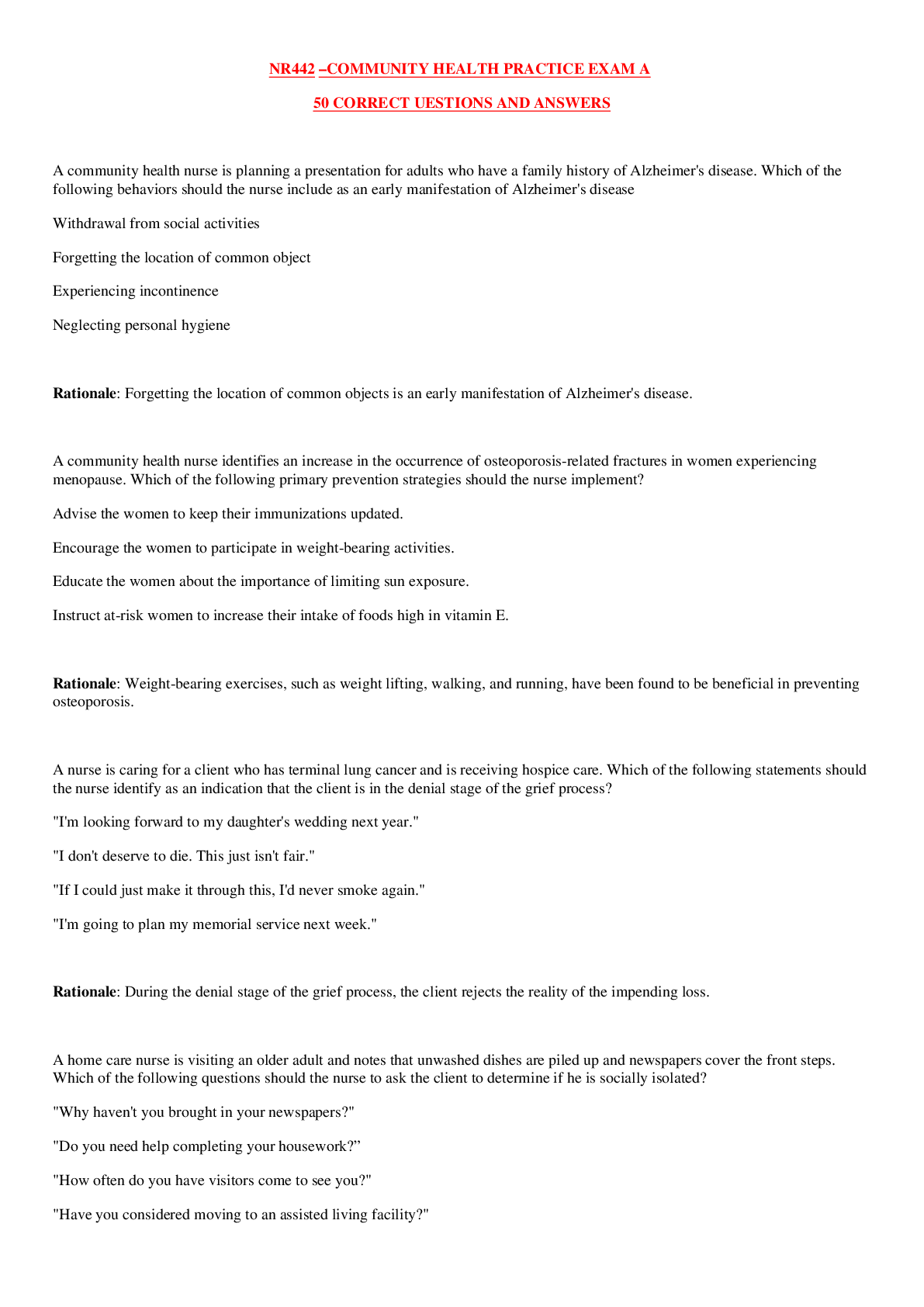
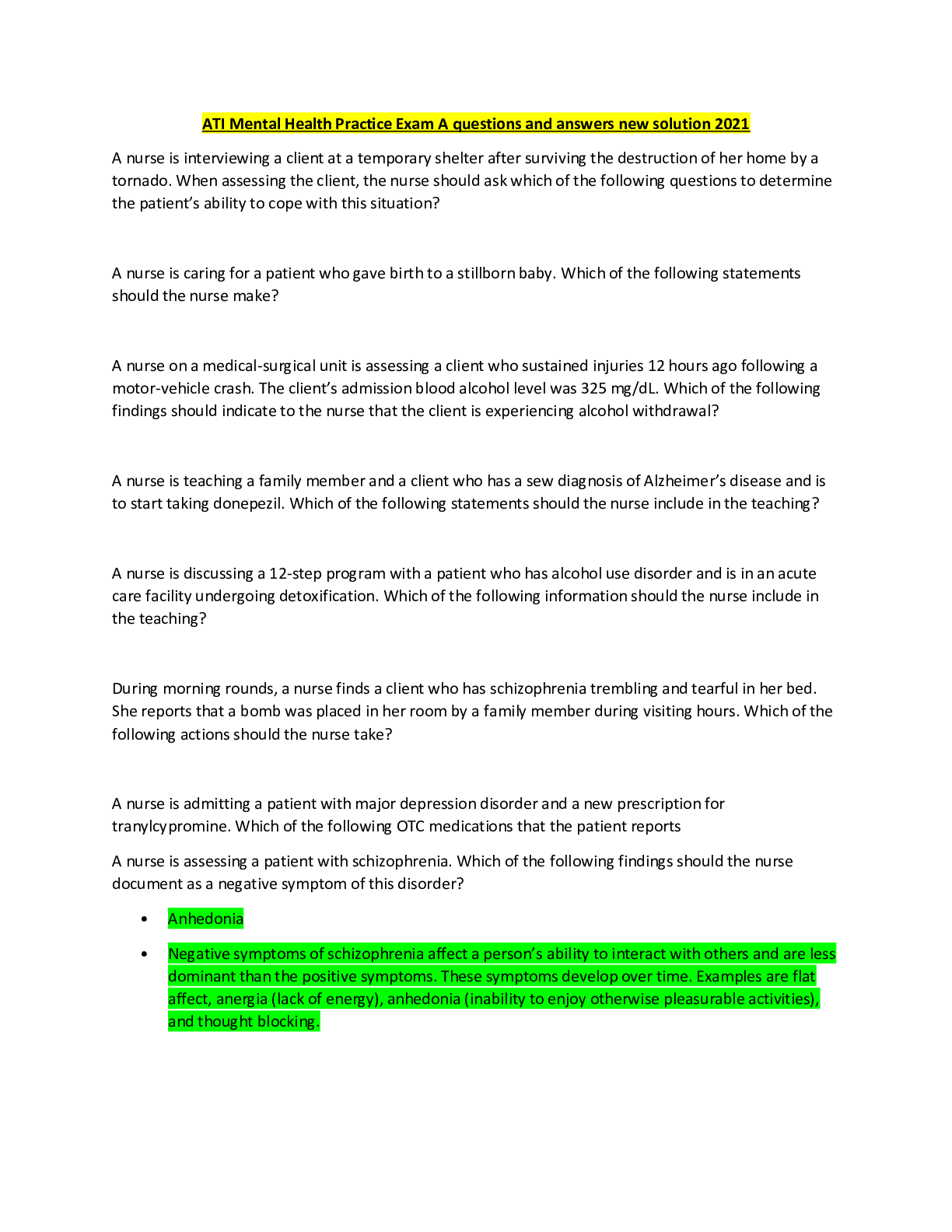
 - Chamberlain.png)

